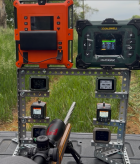Thanks, Jim, for thinking of me to make the tag - I'll try to help here.
Which units have multi-tracking? The LabRadar V1 has had multi-tracking feature for a long time. This feature is supposed to be present in the current firmware version of the LabRadar LX, but I have not yet attempted to use that feature to know if it is operational or not (I know it was not functional within the original firmware of my 1st LX unit when acquired last year). The Caldwell Velociradar also includes multi-tracking, essentially a clone of the LabRadar V1, but I have also not used this feature on the VR. I DID try that feature multiple times with the V1.
Is multi-tracking useful? By and large, no, the BC which we calculate from the multiple readings achieved with these sub-100yrd commercial units really isn't useful for long range or extreme long range shooting. Truing BC at distances far, far farther than 100yrds is required when a single BC doesn't work, and further, using a CDM/PDM or "bullet profile," is far more productive than any single BC. So no, I would not say it is meaningful to purchase a commercial radar unit based on multi-tracking ability.
Can any commercial units capture a pitched ball? Yes, some can, but ONLY if the pitch is fast enough to be registered by the device (above minimum velocity of the unit) AND if the the unit is designed to be triggered by radar signature rather than acoustic or recoil triggers.
Units which cannot pick up baseballs: The Caldwell Velociradar has a minimum detectable velocity of 170mph (250fps) a little too fast for a pitched ball, AND it only has acoustic or recoil triggers, and does not at this time offer a radar trigger option. So the Caldwell VelociRadar cannot be triggered by a baseball, nor will it register a projectile that slow.
The LabRadar LX and V1 have minimum detection speeds also of 44mph, but like the Caldwell Velociradar, they cannot be triggered by radar, and only offers acoustic and recoil triggers.
Units which CAN pick up baseballs: The Garmin Xero C1 WILL and DOES pick up pitched baseballs, assuming pitches are above 44mph (65fps), and I have confirmed this myself. The Athlon Velocity Pro shares the same features as the Garmin (radar trigger + minimum 44mph detection speed), although I have not personally tested the Athlon to be able to pick up pitches. Neither of these units offer multi-distance tracking or BC calculation at this time (not that this is terribly important for pitched balls, or as described above, it's not actually an important feature at all).
The Bushnell speed gun meant for baseballs is much cheaper than a ballistic/shooting sports radar chronograph - $120 on Amazon (and cheaper units do exist, $80 for some, I just personally have the Bushnell unit and can confirm it works well).
Observationally: The Caldwell VelociRadar is essentially a clone of the LabRadar V1 - same aiming issues, same multi-distance tracking feature, same option for acoustic or recoil (attachment) trigger only, same huge physical size. At the current market price of the Caldwell, I'm very ANTI-VelociRadar. If it were priced at parody with the Athlon Rangecraft Velocity Pro or LabRadar V1, $350, I could kind of understand a place in the market for the Caldwell. But at their $500 price point, nah, it doesn't deserve to survive in a capitalist economy. The LabRadar V1 does exactly the same things for lower cost, the LX, Garmin, and Athlon units are smaller with less aiming issues, and the Athlon is cheaper... Ultimately, I believe the market will tell Caldwell to reduce their price to $300-350, where it can fairly compete in market based on its performance and value. Personally, I would consider buying any radar chronograph besides the Garmin Xero C1, Athlon Rangecraft Velocity Pro, or LabRadar LX to be a mistake in the 2025 market. If you want to catch pitches, the Garmin Xero C1 and Athlon Rangecraft Velocity Pro are the options which can do that.












